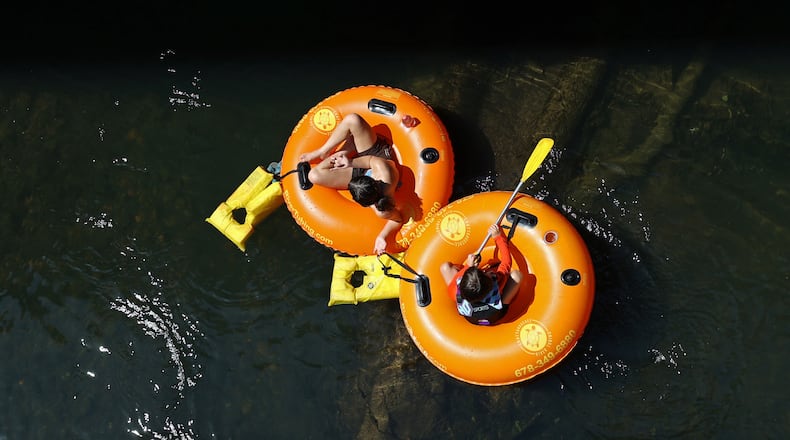Any day now, two MARTA railcars, each 75 feet long and weighing 55,000 pounds, will be dropped into the ocean 23 nautical miles east of Ossabaw Island.
They will join a lot of other man-made things that, by accident or design, have been entombed in the depths of Georgia’s coastal waters and its lakes and rivers.
There is garbage, of course. And at least 1,200 historically significant shipwrecks, some dating back to the early 1700s, according to one estimate. About 20 years ago, tens of thousands of gold and silver coins were retrieved from the SS Republic, a side-wheel steamer that sank in an 1865 hurricane.
But there’s plenty of other stuff you wouldn’t expect to find. And the pile is growing, because we throw in more than we take out.
Usually we don’t see it, or even know it’s there, unless there’s a reason to dig around. Last year, dredging on the Savannah River shipping channel was temporarily halted after crews discovered the first of what turned out to be 15 Revolutionary War-era cannons buried in the river mud.
Sometimes we know what’s lying at the bottom because the water wasn’t there before. Like when it comes to the remnants of former towns that were flooded by new dams. Lake Allatoona houses big stacks from pre-Civil War furnaces used to melt iron ore. During severe droughts, falling water levels at Lake Lanier have exposed the concrete bleachers of a former dirt racetrack.
Credit: David Coughlin / Special
Credit: David Coughlin / Special
Other times, plans are aired publicly. The hulking MARTA cars are being added to artificial reefs for aquatic life. Already out there as part of the state’s reef program: New York City subway cars, M60 battle tanks, World War II cargo ships, old barges and tug boats, chicken cages, broken concrete and the 100-ton bronze propeller removed from the Golden Ray, a container ship that capsized in St. Simons Sound in 2019.
MARTA hasn’t detailed how many more railcars it might donate to further reef building. But it will have a lot to choose from. Atlanta’s transit authority is overhauling its entire 288-car fleet in the next several years.
Many other curiosities, usually smaller, settle on Georgia’s aquatic beds. Things slip out of pockets, tumble over sides of boats and wash down neighborhood storm drains. Sometimes headless goats get tossed off the I-20 bridge over the Chattahoochee River for reasons we’re still trying to figure out (more on that later).
Ervan Garrison knows what’s down there more than most. He’s a University of Georgia anthropology professor who specializes in underwater archaeology. He’s been on plenty of dives. But even his knowledge is limited.
“Sometimes we are fortunate enough to stumble upon it,” says Garrison, who is 80 years old and still occasionally puts on his scuba gear.
UGA houses the Georgia Archaeological Site File, an official repository of reports and details about more than 60,000 cultural sites on land and underwater. Most artifacts are discovered if some kind of project — a bridge expansion, for example – triggers an archaeological review. Often they are documented but not removed because there isn’t enough money to preserve and store it all.
So public access to the state’s site file is restricted to avoid giving a treasure map to looters. By law, artifacts found below high tide lines or highwater marks in state-owned waters belong to the government, according to Rachel Black, Georgia’s state archaeologist.
In years past, Georgia had its own underwater archaeologist, but it hasn’t in recent years, unlike some nearby coastal states. There would be plenty for one to do.
“Everywhere there is water in the state, there is something underneath it,” said Black, who reports to the Department of Natural Resources.
Garrison, the diving professor, likens an underwater discovery to “opening a Christmas present.” Many years ago, he explored an ironclad Civil War ship in the Savannah River. Back on land, he analyzed the ship’s cannons, helping confirm the Confederacy had constructed powerful weapons, not just bought them.
Credit: Curtis Compton
Credit: Curtis Compton
Some discoveries go back further. Garrison has studied stone prehistoric artifacts submerged nearly 20 miles east of Sapelo Island, on what had long ago been dry land. Other things he found weren’t left by humans. On a dive at Gray’s Reef, off Georgia’s coast, a colleague beside him spotted a more than 30,000-year-old jawbone from a gray whale.
Without special care, what’s long survived under mud and water can quickly fall apart after being exposed to the air. Kurt Knoerl, a Georgia Southern University associate professor of history who teaches maritime archaeology, recalls being told about a largely intact 1,000-year-old dugout canoe that people had pulled out of the Ogeechee River. Within 10 years of its extraction, all that remained of the 20- to 25-foot-long find was a three-and-a-half-foot fragment.
Among other delicate artifacts: unexploded ordnances.
In February of 1958, a B-47 bomber jettisoned a nuclear bomb it was carrying after being struck by a fighter jet during a training mission. The 7,600-pound bomb, which the Air Force said did not have the capsule needed to cause a nuclear explosion, apparently fell into Wassaw Sound south of Tybee Island. For weeks, the military searched for the device without success.
An Air Force review in the early 2000s concluded that while the device carried about 400 pounds of conventional explosives and some amount of uranium, the bomb wouldn’t pose a risk if left undisturbed. The military said its location is uncertain, that there was a “very low possibility” of finding it, and that it should be considered “irretrievably lost.”
Closer to Atlanta, cleanup crews have pulled plenty of stuff from the Chattahoochee. It’s usually garbage, often plastic bottles, “tons of golf balls,” and tires, says Jason Ulseth, executive director of the Chattahoochee Riverkeeper. So far this year, the nonprofit’s volunteers have dragged more than 70 tons of trash from the river and feeder creeks, primarily around the metro area.
Credit: Steve Schaefer
Credit: Steve Schaefer
Crews also occasionally come upon guns. A riverkeeper staffer tracking a sewer spill found what turned out to be a pre-Civil War cannon ball lying in shallow Utoy Creek. A couple years ago a local diver with his own YouTube channel found three pipe bombs in the river near West Paces Ferry Road.
That’s not all. “We have found a lot of decapitated goats,” says Ulseth.
He recently spotted 15 more. They are among 700 to 800 headless goat carcasses he estimates have been found over the last five years on the river, mostly downstream of the I-20 bridge near Six Flags.
Law enforcement have been contacted, reporters have asked questions and there’s been speculation about whether the animal bodies are tied to some sort of ritualistic sacrifice. But Ulseth says he’s unaware of anyone solving the mystery.
Other riddles are waiting under the surface.
Years ago, Knoerl, the Georgia Southern historian, worked on a more-than-century-old tugboat that was partially buried by the side of the Savannah River. At some point he took off his digital dive watch to squeeze his hand into a tight spot. Then he forgot to put the watch back on.
He suspects it’s still resting in the boat. And he thinks about who might find it one day.
“Some archaeologist is going to be really confused,” Knoerl predicts.
About the Author
Keep Reading
The Latest
Featured







